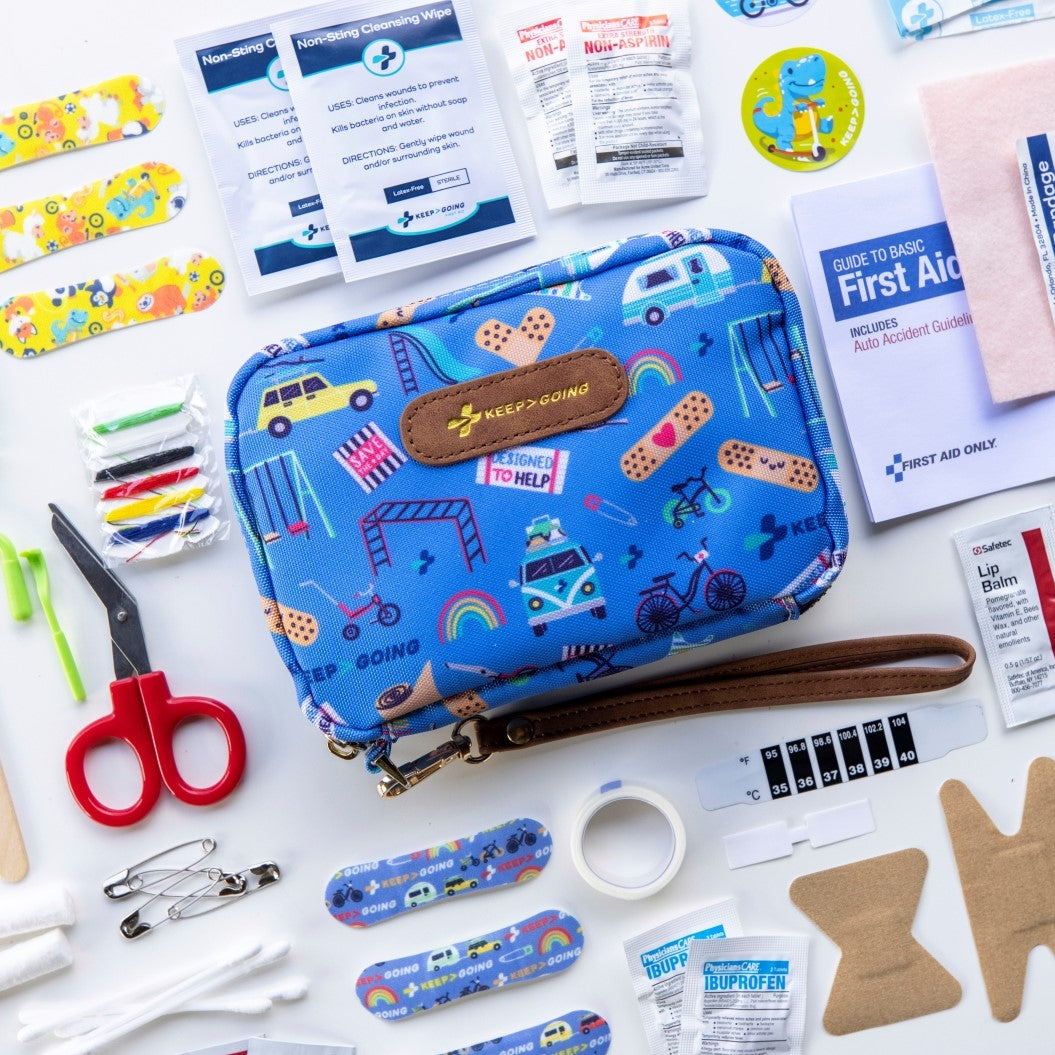Free Shipping over $49
Free Shipping over $49
First Aid Kits
Bandages

5 first aid tips and tricks from the ones who know best: nurses!
May 05, 2022 4 min read
An uptick in injuries is a tell-tale sign that summer is right around the corner. As the school year starts to wind down, the days are getting longer and the kids are outside playing more. To enjoy summer to the fullest, stock up on first aid supplies. You don’t want to be without a bandage if your child falls and scrapes their knee! When our kids fall, it’s our job to show them we are in their corner, dry their tears, and when they are ready to get them patched up and send them out for more fun! To help prepare you for a long summer of bumps and bruises, we’ve gathered 5 super helpful first aid tips from the best in the biz, nurses.
Stop a nosebleed in its tracks
Perhaps one of the messiest incidents you may come up against is a nose bleed. To stop the bleeding, insert nosebleed plugs from your KEEP>GOING First Aid Kit. Next have your child sit down with their mouth open, lean slightly forward (not backwards!) and pinch the middle of their nose shut (pro tip: make them giggle by telling them to act like they just smelled some stinky feet!). Sit like this for 10-15 minutes. It’s best to do this in front of a sink, bowl, or napkin, in case they spit up any blood. Then, release pressure on the nose and check to see if the blood is controlled. If blood is flowing uncontrollably for an extended period of time or any other signs of distress are detected, seek medical help.
How to care for sprains
After a sprain, you must pay the PRICE:
Protection - from further injury
Rest - avoid strenuous activities for 48-72 hours after the injury
Ice - apply an ice pack for 15-20 minutes 2-3 times a day for the first 48-72 hours
Compression - use an elastic bandage to help reduce swelling. Remove at night
Elevation - keep the injury raised above the heart for as long as possible in the first 48-72 hours
Entertain your child with their favorite movies or shows, board games, coloring, puzzles… anything to keep them sitting still! Make sure to stretch and flex the sprain after healing.
Treating minor burns
Whether they touched a hot stove or grabbed a curling iron by accident, minor burns hurt a lot and are sure to produce some tears. The first thing to do after a burn is remove clothes from the area and immediately run the burn under cool -not cold- water for 10-15 minutes. Apply petroleum jelly or grab the burn cream for your KEEP>GOING First Aid Kit and cover the area with a non-stick bandage. Keep the skin moisturized by reapplying petroleum jelly or burn cream 2-3 times a day. To help ease the pain, ibuprofen and acetaminophen are very helpful. When choosing which type of painkiller to give to your child, always consult your doctor first, and pay careful attention to dosing. Be sure to keep the burn out of the sun. If any blisters form, teach your child NOT to poke at them!
Bleeding wounds
When your child suffers a cut that’s bleeding, the first thing to do is to run the cut under cool water to clean the wound, improve visibility of the wound and prevent infection. If you are on the go, use one of the non-sting cleansing wipes from your KEEP>GOING First Aid Kit. Apply gauze or a clean cloth and gently apply pressure, keeping the wound elevated. Continue applying pressure and swap in fresh gauze if blood soaks through. Once the bleeding has slowed, apply a clean bandage to the wound. If you suspect a fracture, do not move the limb. Before you send your child on their way, check for any signs of shock or queasiness. And the most important step: send them off with a sticker and a kiss.
Tick removal and aftercare
Uh-oh! An intruder! First things first, grab your tick remover tool from your KEEP>GOING First Aid Kit. Grasp the tick as close to the skin as possible. Gently and evenly lift the tool very slowly and rotate in either direction several (2-3) turns (pro tip: the tick remover works great for pets, too). After the tick is removed, clean the area with rubbing alcohol or soap and water. Cover with a bandage. NEVER crush the tick with your fingers. Instead, place the tick in rubbing alcohol, a sealed bag or container, wrap it tightly in tape or flush it down the toilet. Make sure to alert your doctor of the tick bite, as they may want to follow up.
When your loved ones get hurt, one of the best things you can do as a parent is be there for your little one, with a caring smile, a warm hug and some fun stickers to help bring a smile back to their face. Add these tips to your SuperParent toolkit for the next time you need to save the day. Follow us on Instagram at @keepgoingfirstaid and like us on Facebook for tips and more!
KEEP>GOING!
The Pepper Family at KEEP>GOING
GET 10% OFF IMMEDIATELY
Subscribe to our Newsletter and receive a 10% coupon when you enter your e-mail address.








